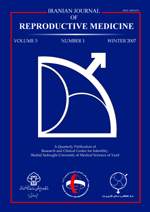
|
International Journal of Reproductive BioMedicine
Research and Clinical Center for Infertility, Shahid Sadoughi University of Medical Sciences of Yazd
ISSN: 1680-6433
EISSN: 1680-6433
Vol. 13, No. 8, 2015, pp. 483-488
|
 Bioline Code: rm15064
Bioline Code: rm15064
Full paper language: English
Document type: Research Article
Document available free of charge
|
|
|
International Journal of Reproductive BioMedicine, Vol. 13, No. 8, 2015, pp. 483-488
| en |
Effects of single dose GnRH agonist as luteal support on pregnancy outcome in frozen-thawed embryo transfer cycles: an RCT
Davar, Robab; Mojtahedi, Maryam Farid & Miraj, Sepideh
Abstract
Background: There is no doubt that luteal phase support is essential to enhance the reproductive outcome in IVF cycles. In addition to progesterone and human chorionic gonadotropin, several studies have described GnRH agonists as luteal phase support to improve implantation rate, pregnancy rate and live birth rate, whereas other studies showed dissimilar conclusions. All of these studies have been done in fresh IVF cycles.
Objective: To determine whether an additional GnRH agonist administered at the time of implantation for luteal phase support in frozen-thawed embryo transfer (FET) improves the embryo developmental potential.
Materials and Methods: This is a prospective controlled trial study in 200 FET cycles, patients were randomized on the day of embryo transfer into group 1 (n=100) to whom a single dose of GnRH agonist (0.1 mg triptorelin) was administered three days after transfer and group 2 (n=100), who did not receive agonist. Both groups received daily vaginal progesterone suppositories plus estradiol valerate 6 mg daily. Primary outcome measure was clinical pregnancy rate. Secondary outcome measures were implantation rate, chemical, ongoing pregnancy rate and abortion rate.
Results: A total of 200 FET cycles were analyzed. Demographic data and embryo quality were comparable between two groups. No statistically significant difference in clinical and ongoing pregnancy rates was observed between the two groups (26% versus 21%, p=0.40 and 21% versus 17%, p=0.37, respectively).
Conclusion: Administration of a subcutaneous GnRH agonist at the time of implantation does not increase clinical or ongoing pregnancy.
Keywords
Frozen; Embryo transfer; GnRH agonist; Luteal phase
|
| |
© Copyright 2015 - Iranian Journal of Reproductive Medicine
Alternative site location: http://www.ijrm.ir
|
|
